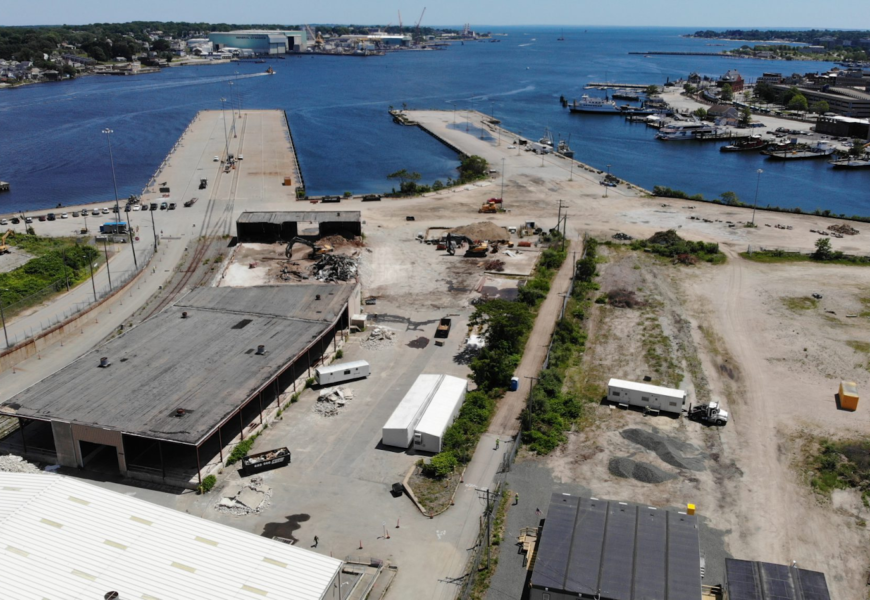For several decades of the 19th-century, New London, Connecticut was one of the busiest whaling ports in the world. In 1876, the Central Vermont Railroad Pier in New London became the first and only 19th-century pier in the state of Connecticut. It brought a boom of trade to the successful seaport city as an interchange point for freight ships and the Central Vermont Railroad network. Whaling fueled the city’s capital and infrastructure, but with the development of alternatives to whale oil, sharp decline of whale populations, and eventual bans on whaling, the city’s economic and industrial success became mostly a thing of the past.
In the early 20th-century, the Connecticut State Pier was built just to the east of the Central Vermont Railroad Pier. The state hoped it would encourage economic development, but it did not have the success of the original pier. It did, however, provide an important port facility to the United States Navy in both world wars and was a contributor to Groton’s ability to establish itself as the “Submarine Capital of the World,” a title it earned by delivering 74 submarines to the Navy in WWII.
In 2019, a project was proposed to connect the two piers to create a larger Connecticut State Pier to serve as a modern heavy-lift port facility capable of supporting the staging and assembly of wind turbine generators for offshore wind energy projects. In February of 2020, the harbor development agreement was finalized and plans to construct the new and improved Connecticut State Pier in New London were set into motion.
The Connecticut Port Authority, a quasi-public agency that oversees Connecticut ports, hopes that the improvements will address previous shortcomings and enhance the State Pier’s ability to capitalize on opportunities for the State of Connecticut. Connecticut has partnered with Ørsted and Eversource, both corporations involved in the energy industry, to fund this project. After its completion, projected to be in spring 2023, the Ørsted and Eversource joint venture company will begin a ten-year lease agreement for the use of the State Pier for wind turbine generator pre-assembly and staging. Three offshore wind projects already lined up will total more than 1700MW of energy production and are already scheduled for delivery from the completed pier facility to sites in New York, Rhode Island, and Connecticut. They are expected to be able to produce enough energy to power one million homes. “To my colleagues in the United States Senate, if you want to see the future of energy in this country, come here, come to New London, come to the State Pier. This is the future of energy in the United States of America,” says U.S. Senator Richard Blumenthal.
With the construction of the State Pier, new job opportunities have already been brought to New London, and with its completion, many more are expected. Ned Lamont, Governor of Connecticut, reports that “This agreement paves the way for a surge in activity in New London and Eastern Connecticut that will cement the state’s position as a leader in the industry. This new partnership achieves the goal of job growth in a critical part of our state, while making investments in clean energy, showing the world, yet again, that Connecticut will be a leader in addressing climate change.”
In periods where Ørsted and Eversource may not have need for the pier, the facility will be marketed to other customers to ensure it is as efficient as possible. This will also establish it as a stable source of employment and economic benefit for New London and surrounding communities. According to Eliza Fawcett of the Hartford Courant, the State Pier promises “a slew of new jobs and economic stability for New London’s next generation of residents.”
Unfortunately, the Connecticut State Pier project has not progressed without setbacks. The project was proposed at $93 million and aimed to be completed by March 2022. The State Pier, still uncompleted, has currently totalled $255 million and is expected to be completed spring of next year. Part of this is because the original estimate did not include all contingencies and expected ‘soft costs,’ including architectural and engineering fees, permits, and legal expenses, which are difficult to determine before a construction project begins. The project estimate was increased by $64 million after relocations to avoid interference with the Cross Sound Ferry and by another $20 million for permits and to accelerate the dredging of the Thames River. The significant discrepancy between the projected and current costs has increased suspicions surrounding the previous deputy secretary of the Office of Policy and Management, Konstantinos Diamantis. The U.S. Attorney’s office has served a federal grand jury subpoena requesting all communication on the topic of school construction, hazardous material abatement, and the State Pier projects involving Diamantis. There has also been dissatisfaction with the actions of the Connecticut Port Authority and its lack of transparency with millions of dollars of taxpayers’ money. With some overturns in the state government and the Connecticut Port Authority, many hope that the future of the State Pier and of all Connecticut ports will be more successful and directly beneficial for affected seaport communities.
For Connecticut College students, improvements to the State Pier will mean an exciting boom in downtown New London. New shops and restaurants can be expected as the city’s population grows. The campus can also expect a potential increase in community interest in campus events, like the College’s theater productions and art exhibits. The development of the State Pier will lead to developments for the City of New London and increasing opportunities for community involvement for interested students.











Great news! Maybe Conn College can start to pay their fair share of taxes to New London like other prominent colleges. Yale just increased support to New Haven considerably………unlike CC that contributes almost nothing while benefitting from municipal services.
Maybe Conn College can start to pay their fair share of taxes to New London like other prominent colleges. Yale just increased support to New Haven considerably………unlike CC that contributes almost nothing while benefitting from municipal services. State Pier will be a construction site. Not exactly sure how that will do all the things in this article.